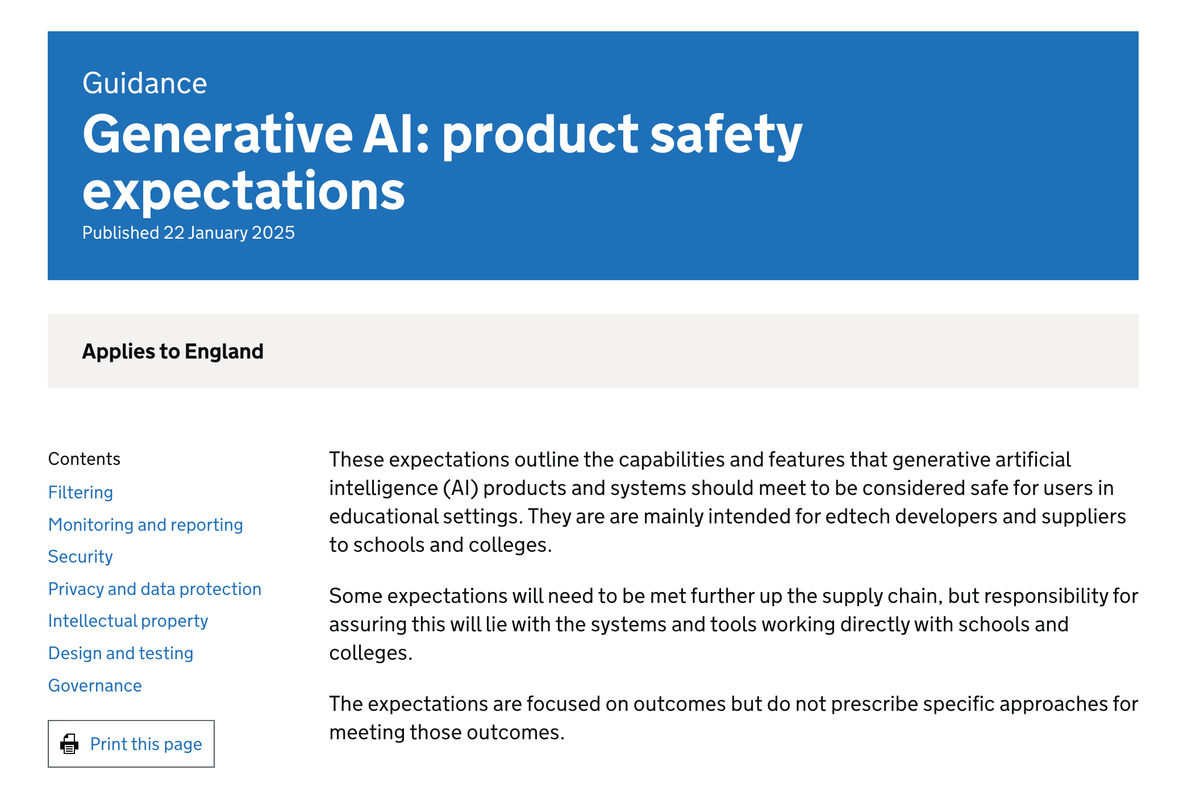Generative AI Safety in Schools: Essential Guidelines for 2024
As schools navigate the opportunities and challenges of AI tools like ChatGPT, clear safety guidelines are essential. This practical guide outlines key policies, safeguarding measures, and implementation strategies to help educational leaders confidently integrate generative AI while protecting s...

Understanding the New Government Framework
The UK Department for Education's AI safety guidelines, published in late 2023, offer important considerations for educational institutions implementing artificial intelligence tools. These guidelines complement existing safeguarding frameworks and provide valuable guidance for developing comprehensive school policies.
Building upon existing educational policy, the DfE's AI and Education guidance outlines essential safety considerations that educational institutions should evaluate when adopting AI technologies. The guidance focuses on three principal areas:
- Protecting student and staff data whilst implementing AI solutions
- Evaluating potential risks and benefits of AI tools through structured assessment
- Aligning AI practices with established child protection measures
These guidelines provide timely support for educational institutions as they explore AI integration. While many schools are beginning to incorporate AI tools for administrative tasks and learning support, the framework offers a balanced approach to innovation that prioritises safety and responsible implementation.
Schools can integrate these AI safety measures within their existing safeguarding frameworks, as the guidelines complement both KCSIE (Keeping Children Safe in Education) requirements and GDPR compliance protocols. This approach allows institutions to enhance their current policies rather than develop entirely separate frameworks for AI governance.
A crucial element of the guidance particularly relevant to educational institutions is its emphasis on comprehensive staff development. The framework recommends that understanding AI safety principles should extend beyond IT departments to include all staff members. This acknowledges the widespread adoption of AI tools across various school functions, from administrative support to teaching and learning activities, whilst ensuring responsible and informed usage throughout the institution.
Key Safety Expectations for AI Tools
Translating these guidelines into practical implementation requires careful consideration of how AI tools function within daily school operations. While the DfE framework establishes foundational principles, educational institutions must develop specific protocols that address their unique operational contexts and student needs. This involves creating robust processes that both safeguard students and optimise the educational benefits of AI technology.
- Data Protection and Privacy: Educational institutions must verify that AI tools process student data in accordance with UK GDPR requirements. This includes thorough assessment of data storage and processing locations. Given that numerous AI platforms operate across international borders, specific data protection measures are essential. International data transfers require particular scrutiny, especially for platforms that maintain data centres outside the UK.
- Content Filtering: Effective AI implementation requires content filtering systems that complement existing safeguarding measures. Key considerations include the capability to restrict inappropriate content and maintain comprehensive usage records. Systems should offer flexibility in adjusting filtering parameters according to different year groups' requirements.
- Age-Appropriate Access: A graduated approach to AI access helps ensure appropriate usage across different age groups. For instance, whilst sixth form students may require advanced AI features for university preparation, younger pupils might benefit from more structured access with additional safeguards.
When implementing these safety measures, educational institutions should consider developing tiered access protocols for AI tools. This approach extends beyond basic content filtering to include customised feature sets that align with students' developmental stages and educational needs. For example, AI-powered research and writing tools can be configured to provide differentiated support across year groups, ensuring appropriate academic development whilst maintaining robust safeguards.
To maintain these safety standards effectively, ongoing professional development should focus on both the practical application of AI tools and the identification of potential risks. Educators benefit from regular updates that reflect emerging challenges and evolving classroom experiences, enabling them to guide students towards responsible AI usage whilst maintaining appropriate safeguards. This collaborative approach to safety helps create a balanced learning environment that maximises educational opportunities whilst protecting student wellbeing.
It is essential to design safety protocols that facilitate, rather than hinder, meaningful educational experiences. Through regular assessment of protective measures and active consultation with the school community, institutions can establish frameworks that support innovative learning whilst upholding their duty of care. This collaborative evaluation process helps ensure that safeguarding measures remain proportionate and effective.
Impact on Existing EdTech Solutions
Educational institutions now face the task of evaluating their existing AI-enabled technologies against the new safety guidelines. Many schools have incorporated various AI tools into their educational environments, including assessment assistance systems and adaptive learning platforms. A thorough review of these implementations helps ensure alignment with current safety standards whilst maintaining their educational value.
To support the evaluation process, schools should conduct a comprehensive review of their educational technology resources. This involves identifying and categorising tools with AI capabilities according to their student engagement levels and potential impact on learning outcomes. A systematic assessment helps institutions prepare for the next phase of implementation, leading to:
- Assessment systems that incorporate intelligent feedback mechanisms
- Virtual learning environments with adaptive capabilities
- Interactive language acquisition tools with speech recognition features
- Differentiated learning systems that adjust to individual progress
Following the identification of AI-enabled systems, institutions should assess each tool across three critical dimensions: data protection protocols, explainability of AI processes, and integration with existing safeguarding measures. This evaluation process benefits from the combined expertise of technical specialists, teaching staff, and child protection coordinators to ensure thorough and balanced assessment.
When reviewing AI-enabled tools, institutions should scrutinise systems that process student information or employ automated decision-making capabilities. Compliance verification requires examination of both GDPR obligations and the latest AI safety protocols. Educational institutions may need to engage with technology providers to obtain current documentation regarding their AI implementations, data handling practices, and processing agreements.
To facilitate this evaluation process, educational institutions should consider the following key actions:
- Creating a comprehensive inventory of AI-enabled tools, including their educational purposes and operational scope
- Examining supplier documentation regarding data protection, AI safety protocols and compliance certifications
- Evaluating each system's potential impact on student privacy and data security through structured risk assessment
- Developing a structured implementation plan to address identified compliance gaps and system improvements
Following the evaluation process, institutions may need to discontinue the use of tools that do not align with current safety guidelines. This transition should be carefully orchestrated, ideally coinciding with term breaks or holiday periods, to maintain educational continuity and allow sufficient time for staff and students to adapt to alternative solutions.
Implementation Strategies for Schools
The implementation of AI safety measures requires a methodical approach that balances technological advancement with student protection. Research and experience suggest that a phased implementation strategy helps institutions address safety requirements systematically whilst maintaining educational continuity.
A successful implementation strategy often begins with forming a diverse working group comprising academic, pastoral and technical staff members. This collaborative structure enables comprehensive oversight of AI safety measures, allowing institutions to gather insights from various educational perspectives and adapt protocols based on practical classroom observations.
- Initial Assessment and Policy Framework: Conduct a thorough evaluation of existing AI applications within the institution. Develop comprehensive guidelines that complement current safeguarding measures and acceptable use policies. The NCSC's AI guidelines can provide additional context for institutional policy development.
- Professional Development Programme: Establish structured training modules that address varying levels of AI expertise. Begin with foundational understanding for all staff members, followed by specialised sessions tailored to specific roles. Incorporate hands-on learning opportunities that enable staff to explore AI applications within a controlled environment.
- Community Engagement: Develop comprehensive resources that outline the institution's approach to AI implementation for all stakeholders. Maintain open channels of communication through established platforms, ensuring regular updates and opportunities for feedback.
To maintain effective oversight, institutions should establish a streamlined monitoring system for AI tool usage across departments. A centralised registration process, potentially integrated with existing IT management systems, enables systematic documentation and evaluation of AI applications. This approach facilitates thorough assessment of new tools whilst ensuring compliance with safety protocols before implementation.
Financial planning is an essential component of AI implementation. Educational institutions should carefully evaluate the total cost of ownership, including initial licensing, ongoing staff development, enhanced security protocols and additional features required for educational purposes. Collaboration between IT and finance departments helps ensure appropriate resource allocation within the institutional budget framework.
To maintain the effectiveness of AI safety protocols, institutions should establish regular evaluation cycles. Conducting systematic reviews each term enables thorough assessment of implementation outcomes and stakeholder experiences. These evaluations help identify areas for refinement whilst ensuring alignment with current technological developments and regulatory standards.
Looking Ahead: Next Steps for School Leaders
As artificial intelligence continues to evolve, educational institutions should develop adaptable safety protocols that anticipate future developments. Beyond the established frameworks, several emerging considerations require careful attention when updating institutional AI governance policies.
Educational institutions can strengthen their AI governance through dedicated oversight committees. These groups should include representatives from key departments to provide diverse perspectives on policy development and risk assessment. Regular committee meetings enable timely responses to emerging challenges whilst ensuring guidelines remain aligned with educational objectives and safety requirements.
Supporting staff development in AI technologies requires a strategic approach. Institutions should establish mentoring networks where colleagues can share experiences and insights about AI implementation. Department-level coordinators can facilitate collaborative learning and provide practical guidance on addressing classroom challenges. The DfE's guidance on AI in education provides valuable context for developing these professional learning communities.
To progress from policy development to practical application, institutions should consider the following implementation steps:
- Conduct systematic reviews of AI policies with representatives from academic, technical and pastoral teams to ensure comprehensive assessment
- Develop structured protocols for documenting and addressing concerns about AI tool usage, incorporating these into existing safeguarding procedures
- Establish an accessible digital repository for AI safety guidelines, training materials and best practice examples
- Integrate age-appropriate guidance on AI literacy and safety into the curriculum, ensuring students develop critical awareness of AI capabilities and limitations
Educational institutions can enhance their AI safety protocols by monitoring authoritative sources of guidance. The National Cyber Security Centre's schools guidance and professional educational technology networks offer valuable resources for understanding emerging developments in AI security and implementation. Regular engagement with these information sources helps institutions maintain current and effective safety measures.
Effective AI safety measures extend beyond technical implementations to foster an environment of thoughtful innovation within educational communities. Through careful development of comprehensive frameworks, institutions can establish protocols that safeguard their stakeholders whilst realising the pedagogical benefits of emerging technologies.




